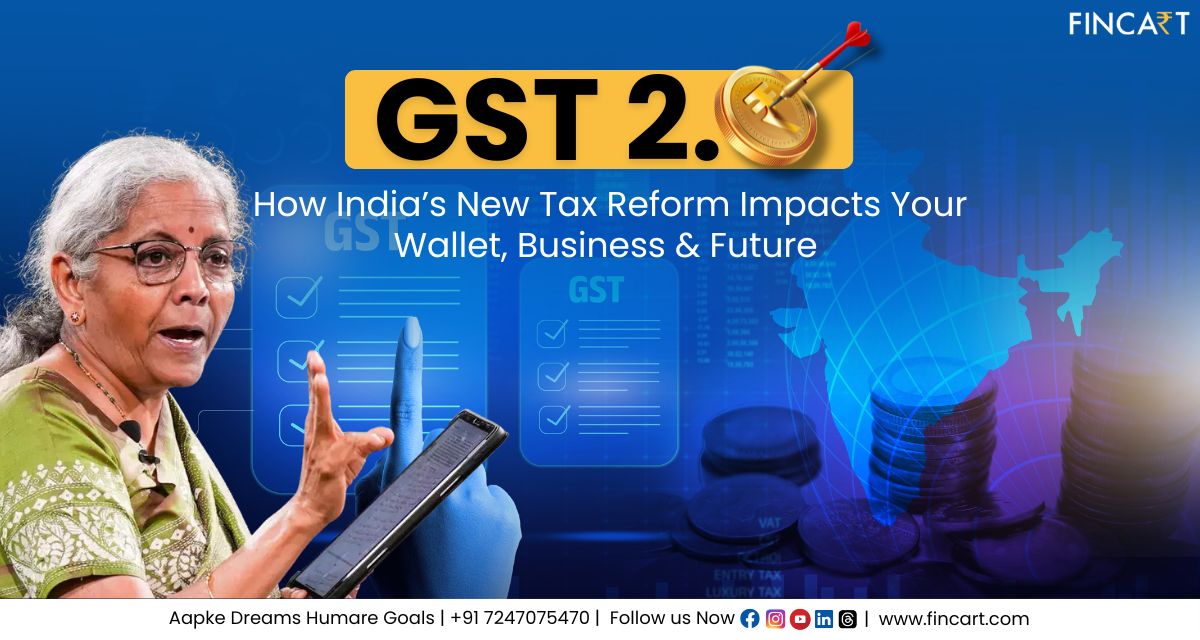India’s tax system just got its boldest makeover since the launch of the Goods & Services Tax (GST) in 2017. Dubbed GST 2.0, this set of sweeping reforms announced by the GST Council in its September 2025 meeting promises to simplify compliance, lower prices on essentials, and unleash fresh momentum for businesses, exporters, and investors.
But here’s the catch — while the announcements sound promising, many people are still asking: What exactly changed? How does this affect my monthly budget? And why are businesses so excited?
This article breaks it all down for you — decoding GST 2.0 in plain English, showing its impact on consumers and businesses, and exploring what lies ahead for India’s economy.
Quick Snapshot of GST 2.0 Reforms
Before we go deep, here’s a bird’s-eye view of what changed:
| Reform | What Changed | Why It Matters |
| Simplified Rate Structure | Four slabs collapsed into two main slabs – 5% & 18% | Easier compliance, better price predictability for consumers & businesses |
| Expanded Exemptions | Education services, healthcare services, daily essentials exempted | Direct savings for households, supports human capital development |
| Faster Refunds | 90% provisional refund for cases involving inverted duty structures | Frees up working capital for exporters & manufacturers |
| GSTAT Operationalized | National-level GST Appellate Tribunal (GSTAT) to start functioning by end of 2025 | Faster dispute resolution, reduces litigation burden |
This high-level summary already shows us a clear trend — GST 2.0 is simplifying, digitizing, and humanizing India’s indirect tax regime.
Impact on Consumers – More Savings, More Spending Power
For ordinary citizens, GST 2.0 brings a wave of relief. Lower rates on goods and services translate directly into more money left in your wallet.
Everyday Essentials Get Cheaper
Items like packaged food, toiletries, plant-based milk, and household cleaning products now fall under the 5% slab, making them more affordable.
Example:
A bar of soap that earlier cost ₹30 + 18% GST (₹35.40) will now cost ₹31.50 with the new 5% slab — saving you nearly ₹4 per unit. Multiply that across your family’s monthly consumption, and the savings start to look significant.
Affordable Healthcare
Medical consultations, diagnostic tests, and hospital stays have been exempted or taxed at lower rates.
- A ₹500 diagnostic test earlier attracted an 18% GST (₹90 tax).
- Under GST 2.0, that’s down to 0% — saving patients money on out-of-pocket healthcare costs.
Education Gets a Boost
School bus services, online learning platforms, and skill-development courses now carry reduced tax rates or exemptions, making them more accessible. This is a major plus for middle-class families struggling with rising education costs.
MSMEs & Startups – Compliance Made Simple
If you run a small or medium business, GST 2.0 is designed with you in mind.
Simplified Filings
Fewer tax slabs mean fewer classification headaches. Return filing formats have been simplified, with AI-powered GSTN systems automatically matching invoices and flagging mismatches in real time.
Example:
Earlier, a small retailer had to spend hours reconciling purchase and sales data manually or pay a CA for compliance. Now, with automated matching and simpler forms, filing can be completed in a fraction of the time — and with fewer errors.
Lower Compliance Costs
By reducing late fees and introducing graded penalties, the new framework ensures that small lapses don’t translate into huge costs. This helps small businesses stay compliant without feeling penalized.
Better Cash Flow
The biggest win is the provisional refund of 90% in cases of inverted duty structure. Businesses no longer have to wait months for refunds, freeing up capital for inventory, salaries, and expansion.
Boost for Exporters & Manufacturers
Exporters often bore the brunt of delayed GST refunds, which blocked their working capital and slowed production.
Under GST 2.0:
- Refunds are now processed automatically, with most of the claim released upfront within 7 days.
- This ensures that exporters can re-invest their money quickly, take on more orders, and compete globally with better pricing.
Case in Point:
A textile exporter paying ₹10 lakh in GST on inputs can now expect ₹9 lakh refunded provisionally within a week — just in time to fund their Diwali shipment production.
This is a huge advantage for sectors like textiles, pharma, electronics, and auto components, which rely heavily on quick turnaround cycles.
Economic Ripple Effect
Lower costs and faster refunds aren’t just good for individuals and businesses — they stimulate the entire economy.
- More Disposable Income: With prices of essentials dropping, households have more to spend on discretionary goods, which boosts sectors like FMCG, electronics, and hospitality.
- More Jobs: Increased demand translates into higher production and more employment opportunities.
- Stronger Formal Economy: Simpler compliance encourages more small businesses to register under GST, widening the tax base and strengthening India’s formal economy.
Think About It:
When lakhs of small traders come under GST thanks to easier compliance, the government collects more tax without raising rates. This extra revenue can then be used for infrastructure and welfare programs — creating a virtuous cycle of growth.
Why These Reforms Matter Right Now
These reforms come at a crucial time when:
- Input costs (fuel, raw materials) have been rising.
- MSMEs have been facing liquidity issues post-pandemic.
- Global economic conditions are uncertain, requiring domestic demand to stay strong.
By reducing tax burdens, improving compliance processes, and boosting working capital, GST 2.0 gives both consumers and businesses the breathing room they need.
What’s Next for GST
The government is expected to keep pushing towards a simpler and more predictable tax regime.
Watch for:
- Further rationalization — merging remaining slabs into a single standard rate.
- Decriminalization of minor offences — to promote ease of doing business.
- More technology-driven initiatives — AI and ML tools to detect fraud, auto-generate returns, and make compliance almost effortless.
The Final Take : GST 2.0
GST 2.0 isn’t just a tax reform. It’s a mindset shift — towards simplification, inclusivity, and growth.
For you, it means:
- Cheaper goods and services
- Easier compliance (if you run a business)
- Quicker refunds if you manufacture or export
- A stronger, more resilient economy that benefits everyone
If you’re a consumer — enjoy the lower costs.
If you’re a business — now is the time to realign your pricing, inventory, and compliance processes to take full advantage of GST 2.0.
Because this isn’t just another policy tweak — it’s a signal that India’s tax system is ready for the next decade of growth.




